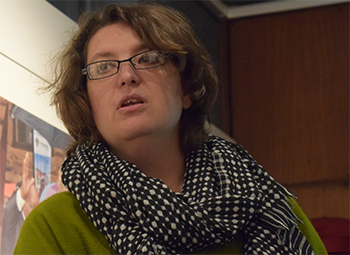

This archaeozoological study was undertaken in order to be able to distinguish between the two hare species (Cape hare and scrub hare) of South Africa in archaeological faunal material. Analyses of modem skeletal material housed in museum collections demonstrated that there are indeed morphological and morphometric differences. The lagomorpha material from the two archaeological rock shelters, Blydefontein and Meerkat, were re-examined utilising the newly established protocols. The re-analyses proved that the established protocols work and that it is now possible to distinguish between the two hares even when fragmented. The dietary and likely cultural roles of the Lagomorpha and other small mammals and animals within the Southern African archaeological context were explored.
Scott provided a context to her presentation, stating that a quarter of the world’s mammal species are found in Africa and to be more particular, the Southern African Sub region has 354 mammals which created a great difference when compared to both European and American Archaeozoology. She went to say that of all the small mammals and according to archaeological studies, bunnies are the major pray species in America and Europe and they are extremely understudied worldwide.
According to Scott’s study, small mammals and animals were not only used for human consumption and that the secondary or non-dietary use of small mammals and animals should be kept in mind in the archaeological records. She added that the use of animals as treatment of ailments affecting humans and livestock had a long and rich history around the world. Scott indicated that many studies tend to focus on the traditional use of plants, deliberately ignoring the many remedies and medicines that feature animal substances. She said it is important to note that not all the medicines were ingested, some were worn and kept close and some were buried just outside the home. She cited a corroborating study that states that the current use of animals in traditional medicine – mammals make up 60% of zoo therapy remedies.
Scott highlighted that the curative role of animal products is often presented as amusing anecdotes and superstition. She said ethnographic explorers were predominantly western European males who would either intentionally or unintentionally bias their accounts as a result of their own cultural prejudice. She insisted that these biases have perpetuated myths and stereotypes relating to labour divisions. She stated that as a result of this too narrow research focus, women’s roles in active hunting have been almost invisible and regarded as passive by the society. She said for these researchers because women, children and the aged mostly hunted small animals that could be gathered without expending a lot of effort, which was seen as “collecting” and not “hunting” and thus not worthy of investigating.
Scott is of the opinion that the overlooking of small mammals over big ones has a lot to do with a perpetuated male centred view of the past. She stated that according to her study, small mammals play a larger role in the dietary habits and cultural archaeological society. The evidence in her study suggested that a concerted effort to retrieve the remains of small mammals and careful examination of this class can add considerably to our knowledge of the past.
*By Katlego Pilane (CHS communications and marketing)
Publish date: 2018/10/16